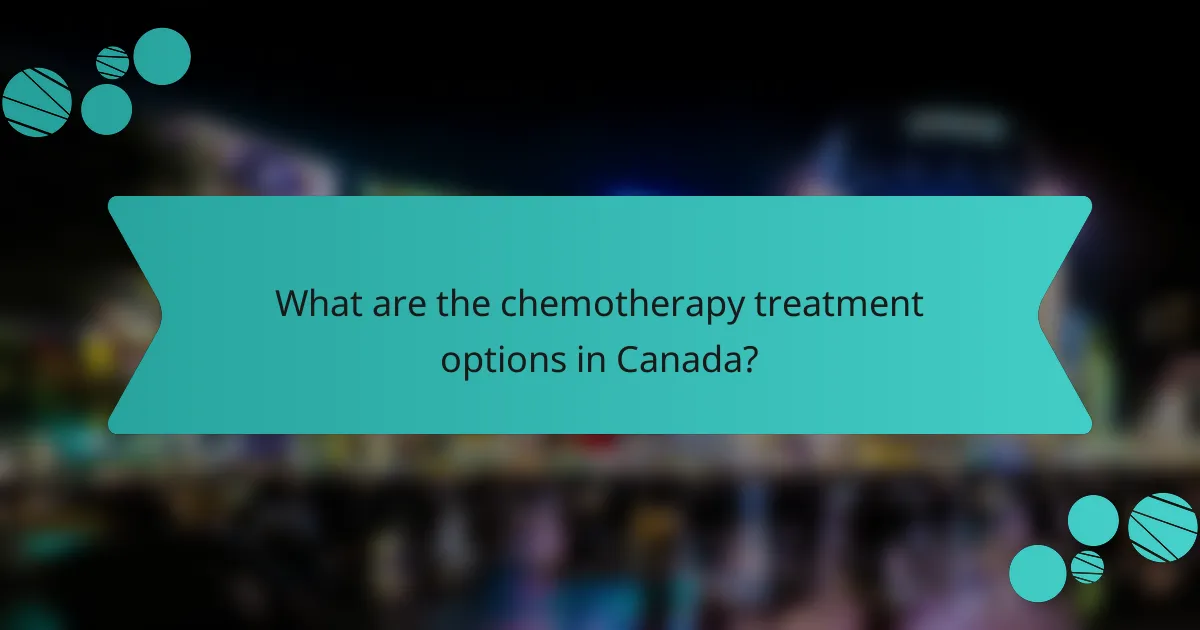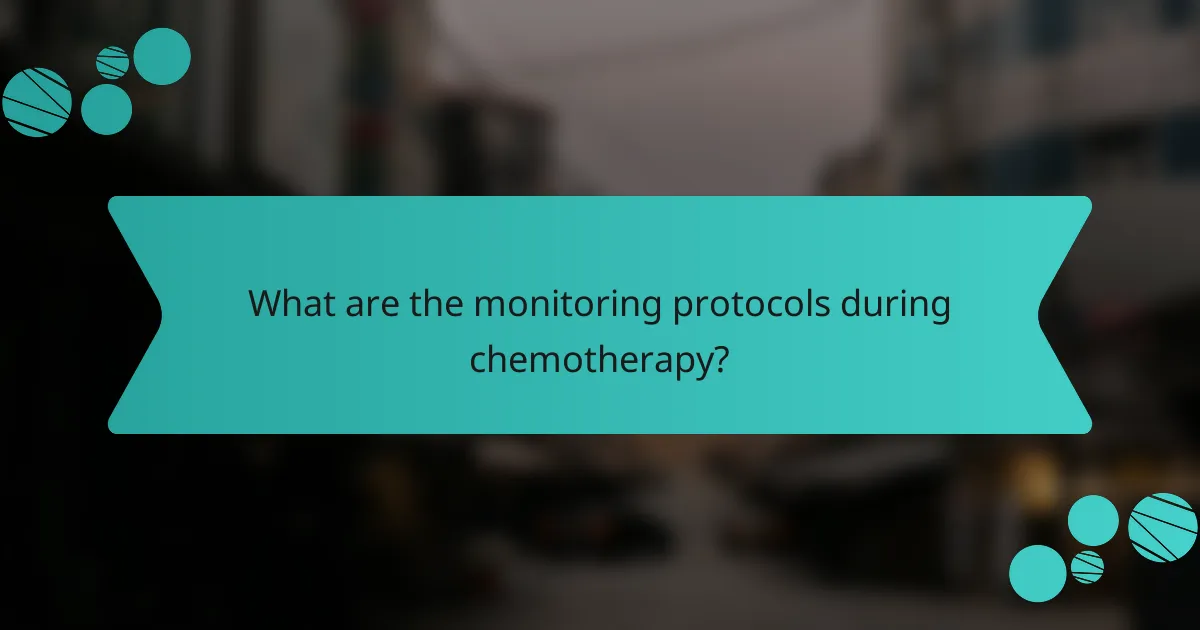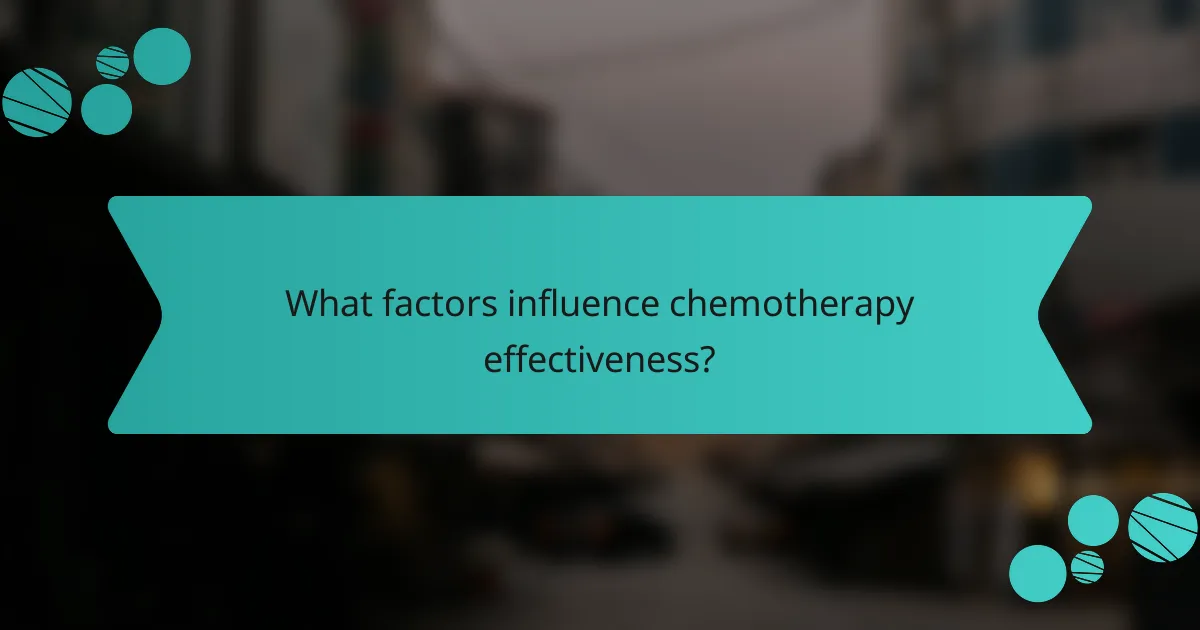Chemotherapy treatment involves a range of drugs designed to target cancer cells, with options tailored to the specific type and stage of cancer as well as individual patient health. Response rates can vary widely, indicating the percentage of patients who experience a reduction or elimination of their cancer. While chemotherapy aims to combat cancer effectively, it can also pose significant challenges to a patient’s quality of life, affecting both physical health and emotional well-being.

What are the chemotherapy treatment options in Canada?
In Canada, chemotherapy treatment options include various drugs that target cancer cells, each with distinct mechanisms and side effects. Patients often receive a combination of these agents based on the type of cancer, stage, and individual health factors.
Cyclophosphamide
Cyclophosphamide is an alkylating agent that interferes with DNA replication, making it effective against several types of cancer, including lymphomas and breast cancer. It is typically administered intravenously or orally, with dosages varying based on the treatment protocol.
Common side effects include nausea, hair loss, and increased risk of infections. Monitoring blood counts is essential during treatment to manage potential complications.
Doxorubicin
Doxorubicin is an anthracycline antibiotic that disrupts DNA synthesis and is widely used for treating breast cancer, leukemias, and lymphomas. It is given intravenously, often in combination with other chemotherapy agents to enhance efficacy.
Patients may experience side effects such as heart toxicity, nausea, and fatigue. Regular cardiac monitoring is recommended to assess heart function throughout treatment.
Paclitaxel
Paclitaxel is a taxane that stabilizes microtubules, preventing cell division, and is commonly used for ovarian, breast, and lung cancers. It is administered intravenously, typically over a few hours.
Side effects can include neuropathy, allergic reactions, and bone marrow suppression. Pre-medication with steroids and antihistamines is often necessary to mitigate allergic responses.
Cisplatin
Cisplatin is a platinum-based drug that forms DNA cross-links, inhibiting cancer cell growth, and is effective against testicular, bladder, and lung cancers. It is usually given intravenously and may require hydration to prevent kidney damage.
Potential side effects include nausea, vomiting, and renal toxicity. Regular kidney function tests are crucial to monitor the patient’s response to treatment.
Gemcitabine
Gemcitabine is a nucleoside analog that disrupts DNA synthesis and is used for pancreatic, bladder, and non-small cell lung cancers. It is typically administered intravenously on a weekly or biweekly schedule.
Common side effects include flu-like symptoms, fatigue, and low blood cell counts. Monitoring blood tests is essential to adjust dosages and manage side effects effectively.

What are the response rates for chemotherapy treatments?
Response rates for chemotherapy treatments vary significantly depending on the type of cancer and individual patient factors. Generally, these rates reflect the percentage of patients whose cancer shrinks or disappears after treatment.
Breast cancer response rates
In breast cancer, response rates to chemotherapy can range from about 60% to 90%, depending on the cancer subtype and treatment regimen. For instance, triple-negative breast cancer often shows higher sensitivity to chemotherapy, while hormone receptor-positive cancers may respond differently.
Factors such as tumor size, stage at diagnosis, and patient health can influence these rates. It’s crucial for patients to discuss their specific situation with their oncologist to understand potential outcomes.
Lung cancer response rates
Lung cancer response rates to chemotherapy typically range from 30% to 60%. Non-small cell lung cancer (NSCLC) generally has lower response rates compared to small cell lung cancer (SCLC), which can respond better to chemotherapy.
Patient characteristics, including smoking history and overall health, also play a significant role in determining response. Oncologists often tailor treatment plans based on these factors to optimize results.
Colorectal cancer response rates
Colorectal cancer patients may experience response rates of approximately 40% to 60% with chemotherapy, particularly in advanced stages. The effectiveness can vary based on whether the cancer is localized or metastatic.
Combination therapies often yield better results than single-agent treatments. Patients should work closely with their healthcare team to explore the most effective options for their specific cancer type and stage.

How does chemotherapy affect quality of life?
Chemotherapy can significantly impact a patient’s quality of life, often leading to both physical and emotional challenges. While it aims to treat cancer effectively, the side effects can affect daily functioning and overall well-being.
Common side effects
Common side effects of chemotherapy include fatigue, nausea, hair loss, and changes in appetite. These symptoms can vary in intensity and duration, depending on the specific drugs used and individual patient responses.
Patients may also experience changes in their immune system, making them more susceptible to infections. Managing these side effects is crucial for maintaining quality of life during treatment.
Impact on daily activities
The side effects of chemotherapy can hinder daily activities, including work, social interactions, and personal care. Fatigue and nausea may lead to reduced productivity and increased absenteeism from work or school.
Emotional challenges, such as anxiety and depression, can further limit engagement in social activities. Support from family, friends, and healthcare providers is essential to help patients navigate these changes.
Support resources in Canada
In Canada, various support resources are available for individuals undergoing chemotherapy. Organizations like the Canadian Cancer Society provide information, counseling, and support groups to help patients cope with treatment-related challenges.
Additionally, healthcare providers can connect patients with local resources, including nutritionists and mental health professionals, to address specific needs during treatment. Accessing these resources can enhance overall quality of life while managing the effects of chemotherapy.

What are the monitoring protocols during chemotherapy?
Monitoring protocols during chemotherapy are essential for assessing treatment effectiveness and managing side effects. These protocols typically include regular blood tests, imaging studies, and patient-reported outcomes to ensure patient safety and treatment efficacy.
Regular blood tests
Regular blood tests are crucial during chemotherapy to monitor the patient’s blood cell counts and organ function. Common tests include complete blood counts (CBC) to check for anemia, infection risk, and platelet levels, as well as liver and kidney function tests. These tests are often performed before each treatment cycle, allowing healthcare providers to adjust dosages or delay treatments if necessary.
Imaging studies
Imaging studies, such as CT scans, MRIs, or PET scans, are used to evaluate the response of tumors to chemotherapy. These studies help determine if the cancer is shrinking, stable, or progressing. Typically, imaging is conducted at baseline and periodically throughout treatment, often every few months, to provide a clear picture of treatment effectiveness.
Patient-reported outcomes
Patient-reported outcomes involve collecting information directly from patients about their symptoms, quality of life, and treatment side effects. This feedback is vital for tailoring supportive care and addressing issues like pain, fatigue, or emotional distress. Regular assessments, often through questionnaires, help healthcare teams make informed decisions about ongoing treatment and supportive measures.

What factors influence chemotherapy effectiveness?
Several factors can significantly impact the effectiveness of chemotherapy, including the type of cancer, the stage at which it is diagnosed, and the overall health of the patient. Understanding these elements can help tailor treatment plans for better outcomes.
Patient health status
The overall health status of a patient plays a crucial role in determining how well chemotherapy will work. Factors such as age, pre-existing medical conditions, and nutritional status can affect the body’s ability to tolerate treatment and respond positively.
For instance, younger patients or those without significant comorbidities may experience better response rates and fewer side effects. Conversely, older patients or those with conditions like heart disease or diabetes may require adjusted dosages or alternative therapies.
Regular assessments of health status, including blood tests and physical examinations, are essential to monitor how well a patient is coping with chemotherapy. This ongoing evaluation can help healthcare providers make necessary adjustments to treatment plans to enhance effectiveness and maintain quality of life.
